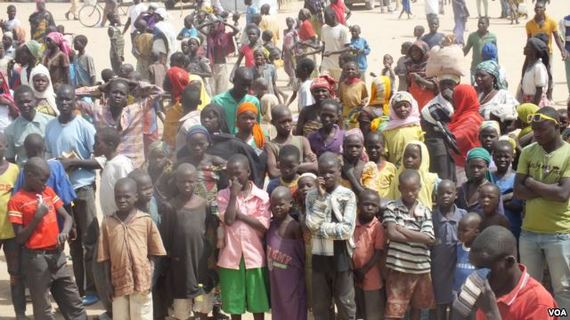It's a tale of hidden suffering of monumental proportions.
The estimated number of internally displaced persons (IDPs) in the world has reached a record 38 million, but that number is still by far an underestimation.
The figure comes from a recent report issued by the Geneva-based Internal Displacement Monitoring Center [IDMC], with 11 million added to the category in the last four years.
The total estimated number of IDPs is now similar to the population of Beijing, New York and London combined.
The newest IDPs come mostly from Iraq, South Sudan, Nigeria, the Democratic Republic of Congo (DRC) and Syria.

Internally displaced Somali women receive food-aid rations at a distribution centre, in an IDP camp in the Somali capital Mogadishu
Syria, in fact, has the highest number of internally displaced, somewhere around 7.6 million people, uprooted within its borders due to the ongoing civil war.
But it's not always warfare that displaces people. The IDMC could have easily add another three million internally displaced people to its survey were it to consider Nepal. That's the number of displaced due to the earthquake in the Kathmandu Valley last month, as estimated by the UNHCR.
Refugee vs IDP status
All who must abandon their homes and are forced to live elsewhere suffer.
But many of those who escape the internal strife in their homelands by fleeing abroad can at least qualify for refugee status, according to the 1951 UN Convention.
Even though they have to subsist in tents and ramshackle huts, and their conditions may be deplorable, many are reachable by international NGOs.
By contrast, those who are internally displaced often fare much worse, as they become truly dispossessed.
Indeed, given state restrictions on international media coverage and public assistance in places like Syria and Iraq, with journalists facing dire predicaments ˗ many have been killed or kidnapped and even a few executed ˗ internally displaced persons are cursed with invisibility, their stories aren't told and recorded.
A United Nations report Guiding Principles on Internal Displacement defines them as:
"...persons or groups of persons who have been forced or obliged to flee or to leave their homes or places of habitual residence, in particular as a result of or in order to avoid the effects of armed conflict, situations of generalised violence, violations of human rights or natural or human-made disasters, and who have not crossed an internationally recognised state border."
It is the "natural or human-made disasters" part of the UN definition that makes the number difficult to quantify and monitor.
All the while the numbers of IDPs are increasing, and quickly.
Although there are millions displaced in the DRC, where 45,000 people continue to die each month and, according to some estimates, more than six million people have died from the impact of a long drawn-out war, there's relatively little media limelight.
Shouldn't one also include the hundreds of thousands of Chinese roaming within the country because of industrial pollution that's devastated their farmland or displaced by various government building projects?

The number of Nigerian refugees fleeing to Cameroon to escape Boko Haram terrorism has doubled within the past month. Shown here is a refugee camp in Minawao on Cameroon's northern border with Nigeria, Feb. 23, 2015.
And what do we know about the hundreds of thousands of Muslim Rohingya population in the Rakhine state who are robbed of their homes due to religious persecution in Buddhist-majority Myanmar?
And what about the displaced montagnards in the central highlands of Vietnam, sent packing because their homeland sits on bauxite-rich hills, now exploited and unearthed by Chinese companies?
In Ukraine, for example, the USF Global Initiative believes Ukrainian IDPs are undercounted, while the UNHCR says the number has "dramatically increased."
Distributions of food and medicine vary from place to place, and IDP protection depends on where they find themselves and which country they are in.
Haiti, for instance, is but a quick jump over from the United States and after the earthquakes in 2010, food and supplies and media coverage came relatively quickly - if chaotically - for earthquake victims.
But after years of civil war in Darfur, hundreds of villages have been destroyed, 400,000 have died, and 2.2 million are now permanently displaced. Many are still facing starvation and ongoing violence.
It's a crisis in which the international response is slow and ineffectual, and world attention is at best sporadic.
Despite our highly-wired and media saturated world, so much suffering remains nevertheless hidden. The international community falls into what is popularly known as "compassion fatigue".
But unless we find the strength to address the current crisis, our world, despite being in a "global age," is far from being a global civilisation.
For all refugees' plight should challenge our conscience and those internally displaced deserve our attention as much as those who fled across borders. Silence and indifference, after all, constitute the sin of omission.
Andrew Lam is an editor with New America Media and author of the "Perfume Dreams: Reflections on the Vietnamese Diaspora," and "East Eats West: Writing in Two Hemispheres." His latest book is "Birds of Paradise Lost," a short story collection, was published in 2013 and won a Pen/Josephine Miles Literary Award in 2014.
